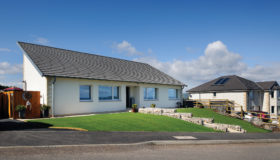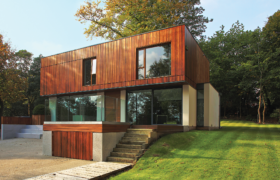

Alison Poole has followed in her grandmother’s footsteps by building a house on a Cumbrian hillside, close to the sea. Her entrepreneurial grandmother was so inspired by a house she saw at the Ideal Home exhibition at Earls Court – 85 years ago, when she was 30 – that she decided to construct her own version of it in the garden of the family home.
“Here was this young lady building her own property at a time when it was virtually unheard of – particularly for a woman on her own,” says Alison. “She was truly inspirational.”
The house was unremarkable by modern day standards, but it nevertheless turned out to be the catalyst that sparked a long-term transformation of the village street, where more than five generations of Alison’s family have lived since the 1800s.
By the time Alison inherited the two-bedroom property 20 years ago it was looking tired and dated. For a while it was rented out, before Alison started to look at the possibility of transforming the bungalow by converting the loft space, extending and refurbishing throughout – all within the confines of permitted development.
“The further I got into it, the more I began to realise that the existing layout was too restrictive,” she says. “I started work on a completely new, very different design, which would take it beyond permitted development and require planning permission.”
Alison’s new design focused on light, space, taking in the beautiful Lakeland views and a big dining/entertaining area. “Over the years we’ve had a lot of family events here so I wanted the new house to include an area where there was enough room for everyone to sit around a large table at mealtimes,” says Alison. “I also wanted to make better use of the sloping site, the lovely light up here and the views over open countryside, without compromising the streetscape.”
Alison and her husband, Jason, held a number of pre-application meetings with South Lakeland’s planning authority to discuss their proposals in-depth, and to agree a basis for the design before submitting the detailed plans. “I wanted to create a modern, eco-friendly cottage that was in keeping with both the local vernacular but that also adhered to the design guidelines set out in South Lakeland’s local plan and supplementary planning documents,” she says.
It was Alison’s first domestic self-build and she wanted to ensure that all bases were well covered before she began. So she also brought on board a second architect, Andrew Yeats from EcoArc, who wrote the detailed specification, prepared construction details and helped run the project on site.
In addition she hired a structural engineer, quantity surveyor and a locally-based contractor to help pull together the project while she travelled regularly between the family’s home in London and Cumbria.
“I was fitting it in around everything else so there were monthly site meetings and lots of phone calls in between,” says Alison. Although she took the lead with the design of the house, the major decisions were made in collaboration with Jason who was, she says, her ‘sounding board’, even though he was working abroad for much of the time.
It was with mixed emotions that the house built by her grandmother was finally demolished – following an asbestos survey that revealed nothing untoward. Although a significant element of family history was being torn down, Alison was excited by the fact that four years of planning and dreaming were finally coming to fruition.
The build was relatively straightforward, but a low bedrock level led to the replacement of proposed raft supports with stepped mass concrete and slab foundations. Once these were laid, the walls shot up within four weeks, comprising 200mm of insulation sandwiched between two layers of concrete block.
The superstructure was simple but the two architects – Alison and Andrew – added various elements to upgrade its eco-values. These included Argon-filled triple glazing, a solar hot water system and insulating tape to make the house as airtight as possible.
“We considered solar photovoltaic (PV) panels for electricity and a heat recovery system, too, but our bills were always going to be quite low as we only live here part of the year,” says Alison. “The orientation is not ideal for PV, so we would have had to install panels rights across the roof and one in the garden to maximise its efficiency.
“However, the solar hot water has been fantastic. The highest water temperature I have seen on the controls was 70°C in early July 2014, which shows how effective it is. There was only one occasion when the boiler was switched on last summer.”
Kerb appeal was a key factor in Alison’s design. The Burlington slate roof is in keeping with the village and the stone render reflects the style of many Lakeland houses, but there was a danger that the house could look too bulky and imposing in its setting.
To avoid this, Alison designed a balcony to break up the front elevation and chose windows with horizontal glazing bars to stretch the visual effect lengthways. There was one design feature, however, which proved to be a disaster.
Alison had included parapets in the plans to match the roof on her parents’ neighbouring house, but the walls turned out to be so deep – due partly to the insulation thickness – that the parapets looked incongruous. “I did a lot of soul searching and eventually decided they had to come down again,” says Alison. “It cost a further £7,000 but it was definitely the right thing to do. They just didn’t look right and I would have never grown used to them.”
In spite of the extra cost and time involved in dismantling the parapets, Alison still came well within the £350,000 maximum budget and only slightly behind the estimated timescale. “We spent a long time researching before we applied for planning permission,” she says. “By the time we started the build we had a very good idea of what it would cost, including a contingency fund if we needed it. I can’t emphasise enough the value of having an outline cost plan, a detailed specification and a bill of quantities.”
Landscaping also played a key role in the success of the build. Alison wanted the areas close to the house to be structurally-based, sloping away to the garden at the back. Natural materials such as timber, setts from a local quarry and large feature stones bought for around £50 are the basis of the formally designed areas. The materials from the disastrous parapets have been used in the landscaping and create stepping stones around the garden.
“It must be every architect’s dream to build their own house and I still pinch myself that I have been lucky enough to do it. I loved doing the project myself and being able to design everything, inside and out, to our own spec and design,” says Alison.
“I’m used to working on much larger developments to a commercial brief, where I am required to work to exacting space standards. But this project gave me a great sense of freedom. I could allow the spaces to flow together without restrictions. I had the luxury of thinking time so I could mull things over and work out exactly what I wanted from the house.”
Alison’s attention to detail has paid off – she adores her new home, and her parents completely admire their daughter’s design. The neighbours have also given their seal of approval to a property that works so sympathetically with its surroundings.
“I love the fact that we are all so close together and that we can continue the family tradition of living in the village,” says Alison, who is helping her brother renovate a bungalow he has inherited on the family site. “One of my favourite views from the house is from our bedroom window. I can see my parents’ house and the window into the room where my father was born. It brings the story of our lives here full circle.”
But there is one more element to the build that ties it to the family. Alison’s grandmother was called Norah Helm and the house will be called Ellanorah in her memory. “It is also the Aboriginal word for ‘a home by the sea,” says Alison. “I like to think she would approve of the house and be proud of the inspirational legacy she left me.”
Published: Build It magazine January 2015

